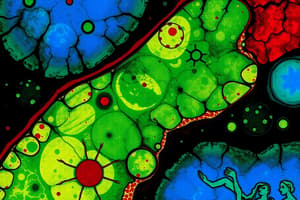Podcast
Questions and Answers
What is the primary role of Azure B in the Air Dried Giemsa stain?
What is the primary role of Azure B in the Air Dried Giemsa stain?
- Stain acidic groups in cells (correct)
- Stain granules of neutrophils (correct)
- Fix tissue fragments
- Provide cytoplasmic transparency
Which statement about Eosin Y is accurate?
Which statement about Eosin Y is accurate?
- It highlights cytoplasmic granules without any clarity.
- It binds to basic groups like hemoglobin. (correct)
- It is a basic dye that stains nuclear chromatin.
- It is ineffective in staining basophil granules. (correct)
Which characteristic feature is NOT associated with the cytoplasm when using the Air Dried Giemsa stain?
Which characteristic feature is NOT associated with the cytoplasm when using the Air Dried Giemsa stain?
- Transparency in cytoplasm
- Visible inclusions in the cytoplasm
- Variety of cytoplasmic granules
- Distinct chromatin highlights (correct)
What is a limitation of the Air Dried Giemsa staining method regarding cells?
What is a limitation of the Air Dried Giemsa staining method regarding cells?
In the context of the Air Dried Giemsa stain, what is meant by chromatin features being distinct?
In the context of the Air Dried Giemsa stain, what is meant by chromatin features being distinct?
Flashcards
Air Dried Giemsa Stain
Air Dried Giemsa Stain
A staining technique that utilizes two components: Azure B and Eosin Y.
Azure B
Azure B
The basic dye used in the Air Dried Giemsa Stain, which stains acidic components like nucleic acids and cell nuclei.
Eosin Y
Eosin Y
The acidic dye used in the Air Dried Giemsa Stain, which stains basic components like hemoglobin.
Air-Dried Giemsa Stain
Air-Dried Giemsa Stain
Signup and view all the flashcards
Air-Dried Giemsa Stain
Air-Dried Giemsa Stain
Signup and view all the flashcards
Study Notes
Air Dried Giemsa Stain
- Principle: Two components - Azure B and Eosin Y
- Azure B bound to anionic molecules
- Eosin Y is anionic
- Acidic groups (nucleic acids and proteins) take up the basic stain of Azure B
- Basic group of hemoglobin binds to acidic eosin
- Granules of neutrophils (leucocytes) stained by Azure B
- Eosinophil granules stained by acidic eosin
- Basophil granules contain heparin, which has affinity for basic components of dye
PAP Stain
- Fixation: Rapid fixation in 95% ethanol
- Cytoplasmic transparency and highlights keratinization
- Nuclear features: Crisp identification of nuclear chromatin detail
- Nucleoli: Well demonstrated
- Tissue fragments: Individual cells clearly seen
Giemsa Stain
- Fixation: Air dried, not fixed
- Highlights variety of cytoplasmic granules and inclusions
- Chromatin features distinct
- Stain assessed
General Notes
- Cytological smear: Means well-stained smear, with various cell details
- Not always nimble: Cells may not be perfectly visible due to heavily stained background
Studying That Suits You
Use AI to generate personalized quizzes and flashcards to suit your learning preferences.
Description
This quiz covers the principles and applications of various cytological staining techniques, including Air Dried Giemsa Stain, PAP Stain, and Giemsa Stain. Each technique's fixation methods, cellular features, and staining characteristics are explored for a comprehensive understanding of cytology. Test your knowledge on these important staining methods used in laboratory diagnostics.




